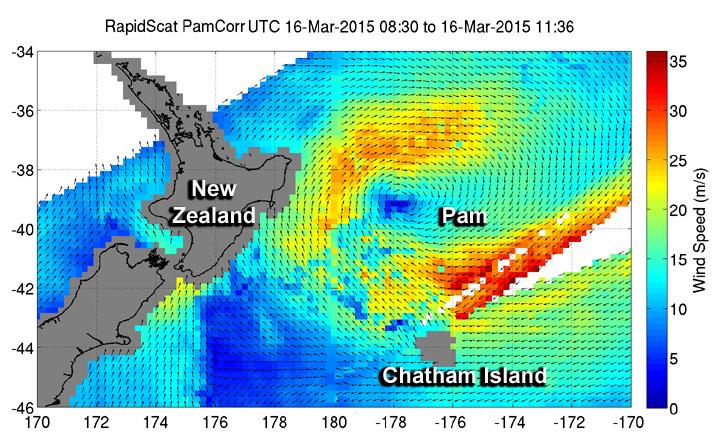RapidScat eyes Ex-Tropical Cyclone Pam's winds near Chatham Islands

RapidScat revealed sustained winds over 30 meters per second/108 kph/67 mph (in red) were still occurring southeast of Pam's center on March 16. Image Credit: NASA JPL/Doug Tyler
The International Space Station's RapidScat instrument captured data on Ex-Tropical Cyclone Pam's winds on March 16 from 08:30 to 11:36 UTC.
RapidScat revealed sustained winds over 30 meters per second (108 kph/67 mph) were still occurring southeast of the center.
The forecast calls for southwesterly winds to 50 knots (57 mph/92 kph) with high seas easing. The “easterly swell 4 meters and southwest swell rising to 7 meters. Poor visibility in heavy rain at times.
On March 17 (or 12:17 a.m. local time, March 18), the New Zealand Meteorlogical Service bulletin stated “Ex Tropical Cyclone Pam lies southeast of the Chatham Islands today, leaving a south to southwest flow over New Zealand.
A ridge moves onto New Zealand on Thursday.” For updated forecasts,visit: http://www.
Media Contact
All latest news from the category: Earth Sciences
Earth Sciences (also referred to as Geosciences), which deals with basic issues surrounding our planet, plays a vital role in the area of energy and raw materials supply.
Earth Sciences comprises subjects such as geology, geography, geological informatics, paleontology, mineralogy, petrography, crystallography, geophysics, geodesy, glaciology, cartography, photogrammetry, meteorology and seismology, early-warning systems, earthquake research and polar research.
Newest articles

NASA: Mystery of life’s handedness deepens
The mystery of why life uses molecules with specific orientations has deepened with a NASA-funded discovery that RNA — a key molecule thought to have potentially held the instructions for…

What are the effects of historic lithium mining on water quality?
Study reveals low levels of common contaminants but high levels of other elements in waters associated with an abandoned lithium mine. Lithium ore and mining waste from a historic lithium…

Quantum-inspired design boosts efficiency of heat-to-electricity conversion
Rice engineers take unconventional route to improving thermophotovoltaic systems. Researchers at Rice University have found a new way to improve a key element of thermophotovoltaic (TPV) systems, which convert heat…



